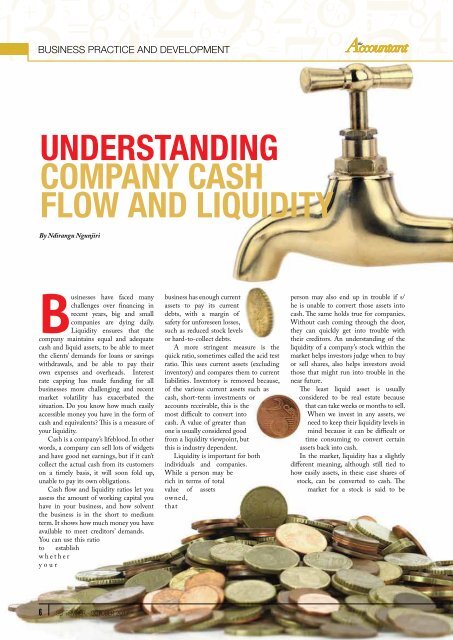The-Accountant-Sep-Oct-2017-Final
You also want an ePaper? Increase the reach of your titles
YUMPU automatically turns print PDFs into web optimized ePapers that Google loves.
Business Practice and Development<br />
UNDERSTANDING<br />
COMPANY CASH<br />
FLOW AND LIQUIDITY<br />
By Ndirangu Ngunjiri<br />
Businesses have faced many<br />
challenges over financing in<br />
recent years, big and small<br />
companies are dying daily.<br />
Liquidity ensures that the<br />
company maintains equal and adequate<br />
cash and liquid assets, to be able to meet<br />
the clients’ demands for loans or savings<br />
withdrawals, and be able to pay their<br />
own expenses and overheads. Interest<br />
rate capping has made funding for all<br />
businesses more challenging and recent<br />
market volatility has exacerbated the<br />
situation. Do you know how much easily<br />
accessible money you have in the form of<br />
cash and equivalents? This is a measure of<br />
your liquidity.<br />
Cash is a company’s lifeblood. In other<br />
words, a company can sell lots of widgets<br />
and have good net earnings, but if it can’t<br />
collect the actual cash from its customers<br />
on a timely basis, it will soon fold up,<br />
unable to pay its own obligations.<br />
Cash flow and liquidity ratios let you<br />
assess the amount of working capital you<br />
have in your business, and how solvent<br />
the business is in the short to medium<br />
term. It shows how much money you have<br />
available to meet creditors’ demands.<br />
You can use this ratio<br />
to establish<br />
whether<br />
your<br />
business has enough current<br />
assets to pay its current<br />
debts, with a margin of<br />
safety for unforeseen losses,<br />
such as reduced stock levels<br />
or hard-to-collect debts.<br />
A more stringent measure is the<br />
quick ratio, sometimes called the acid test<br />
ratio. This uses current assets (excluding<br />
inventory) and compares them to current<br />
liabilities. Inventory is removed because,<br />
of the various current assets such as<br />
cash, short-term investments or<br />
accounts receivable, this is the<br />
most difficult to convert into<br />
cash. A value of greater than<br />
one is usually considered good<br />
from a liquidity viewpoint, but<br />
this is industry dependent.<br />
Liquidity is important for both<br />
individuals and companies.<br />
While a person may be<br />
rich in terms of total<br />
value of assets<br />
owned,<br />
that<br />
person may also end up in trouble if s/<br />
he is unable to convert those assets into<br />
cash. <strong>The</strong> same holds true for companies.<br />
Without cash coming through the door,<br />
they can quickly get into trouble with<br />
their creditors. An understanding of the<br />
liquidity of a company’s stock within the<br />
market helps investors judge when to buy<br />
or sell shares, also helps investors avoid<br />
those that might run into trouble in the<br />
near future.<br />
<strong>The</strong> least liquid asset is usually<br />
considered to be real estate because<br />
that can take weeks or months to sell.<br />
When we invest in any assets, we<br />
need to keep their liquidity levels in<br />
mind because it can be difficult or<br />
time consuming to convert certain<br />
assets back into cash.<br />
In the market, liquidity has a slightly<br />
different meaning, although still tied to<br />
how easily assets, in these case shares of<br />
stock, can be converted to cash. <strong>The</strong><br />
market for a stock is said to be<br />
6 september - october <strong>2017</strong>

















